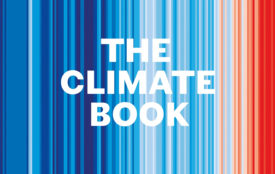“Alice, the Zeta Cat and Climate Change”: A fairytale about the truth
On a school field trip to Potsdam’s Telegraph Hill, Alice runs after a white rabbit – and falls into a hole, sliding down the ventilation shaft of a climate research institute’s supercomputer. From here on follows a journey through the virtual world of computer models, from tropical rainforests to the ice of Antarctica.
This is the rather unusual beginning of a new publication from the Potsdam Institute for Climate Impact Research (PIK), in very free adaptation of Lewis Carroll’s philosophical children’s book classic “Alice in Wonderland”. More than 50 scientists provided their expertise for this work by Margret Boysen, which is being presented at this year’s Leipzig Book Fair and is now available in German book shops. An English version is in planning.
“This lovely book, which should have the widest possible reach, tells the epic climate-change story in terms of a ‘fairytale about the truth’,” says Lord Martin Rees, former President of the Royal Society and Master of Trinity College in Cambridge.
The story starts with little calculation steps in the snow, culminates in a chaotic climate conference which transmutes into a tribunal, and even lands Alice in prison, where gravitation physics fortunately provides a liberating formula. Never before has the science on human-made global warming and its impacts – from record weather extremes to sea-level rise – been presented in this kind of literary manner. “’Alice, the Zeta Cat and Climate Change’ is an accomplished, highly creative and linguistically sophisticated allegory that contributes to and enriches science communication”, says Joachim Müller-Jung from Frankfurter Allgemeine Zeitung, a leading German daily newspaper.
Logic and poetry alone do not suffice – compassion is needed
The author, a geologist by training, leads PIK’s Artist in Residence programme which regularly brings writers or artists to Potsdam for a few months’ exchange between the arts and science. “It has been a pleasure to turn the already absurd tale of ‘Alice in Wonderland’ upside down, and to build a bridge from there to some of the most exciting scientific insights of our times,” comments Boysen about her book. “Carroll’s Cheshire Cat only tells Alice that right and left do not matter: wherever the girl turns, she’ll meet lunatics. The mathematical-metaphorical cat Zeta, however, tells Alice about paths that lead out of the catastrophe,” Boysen says, alluding to the cat’s ability to make any scientific fact or phenomenon easy to understand by explaining it in a visual way.
“Since logic and poetry alone do not suffice to avoid dangerous global warming, but can only describe them, my book is also about compassion or indifference. We humans will only choose the right paths if we can empathise with the fate of others – this is what my protagonist does.” Whether it’s about Professor Glazival who drowned in a flood of data, an abducted walrus or the albatros lady Molly Mauk who’s under suspicion of ‘terraism’ – Alice decides to show her colours.








